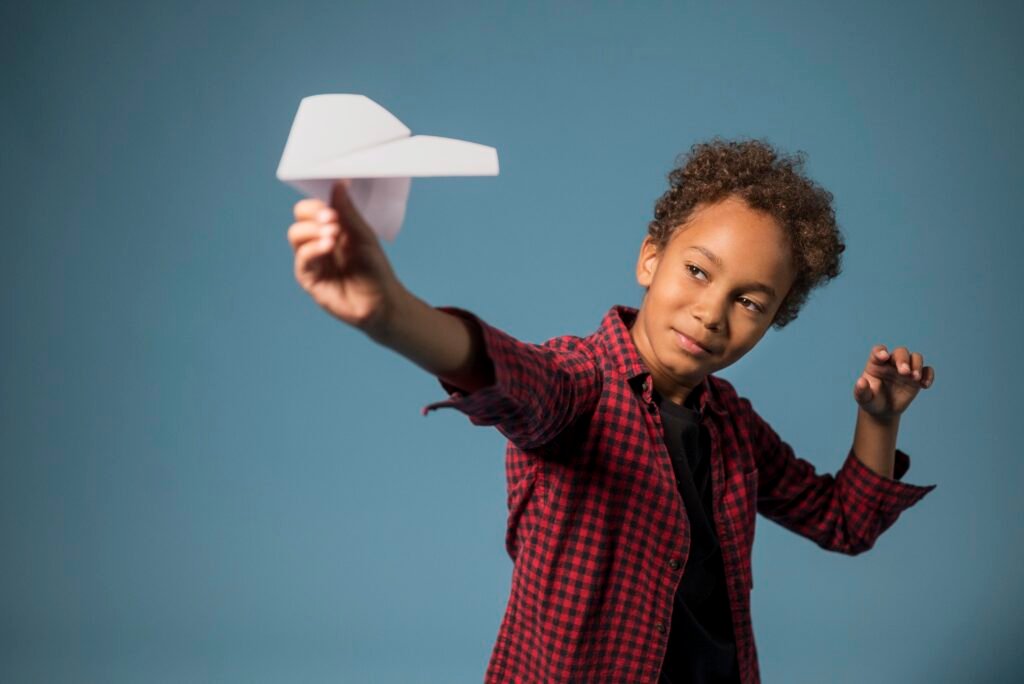Creativity and imagination are essential components of childhood development, allowing children to explore their world, express themselves, and develop critical thinking skills. Nurturing creativity and imagination in children is crucial for fostering innovation, problem-solving abilities, and a lifelong love of learning. In this blog post, we’ll explore the importance of creativity and imagination in child development and provide practical strategies for parents to foster these qualities in their children.
Creativity and Imagination In Child Development
Creativity is the ability to generate new ideas, insights, and solutions, while imagination is the capacity to mentally visualize and explore alternative realities. Both creativity and imagination are essential cognitive skills that contribute to children’s intellectual, emotional, and social development.
Creativity and imagination play a crucial role in child development, helping children make sense of their experiences, express themselves, and engage in meaningful play. By nurturing creativity and imagination in children, parents can support their cognitive development, enhance their problem-solving abilities, and promote their overall well-being.
Creating a Creative Environment

Creating a creative environment at home is essential for fostering creativity and imagination in children. Providing opportunities for open-ended play and exploration allows children to engage their imagination, experiment with ideas, and express themselves freely.
Setting up a dedicated creative space, such as an art corner or a dress-up area, encourages children to engage in artistic expression and imaginative play. By designating a specific area for creative activities, parents signal to their children that creativity is valued and encouraged in the home.
Encouraging curiosity and experimentation is another important aspect of creating a creative environment. By exposing children to a variety of experiences, materials, and stimuli, parents can inspire their curiosity and fuel their imagination.
Fostering a Culture of Creativity
Fostering a culture of creativity at home involves embracing mistakes and failures as learning opportunities. Encouraging children to take risks and explore new ideas without fear of judgment allows them to develop confidence in their creative abilities and resilience in the face of challenges.
Encouraging divergent thinking, or the ability to generate multiple solutions to a problem, is another key aspect of fostering a culture of creativity. By encouraging children to think outside the box and consider alternative perspectives, parents promote creativity and innovation.
Celebrating creativity and valuing creative pursuits sends a powerful message to children about the importance of creativity in their lives. By recognizing and celebrating their creative achievements, parents reinforce their children’s confidence and motivation to engage in creative activities.
Stimulating Imagination Through Play
Stimulating imagination through play is a fun and effective way to nurture creativity and imagination in children. Providing toys and materials that encourage imaginative play, such as building blocks, dress-up costumes, and pretend play sets, allows children to engage their creativity and explore their imagination.
Engaging in pretend play and storytelling activities with children provides opportunities for imaginative expression and creative exploration. By encouraging children to invent their own stories, characters, and worlds, parents stimulate their imagination and promote their storytelling abilities.
Encouraging children to use their imagination in everyday activities, such as cooking, gardening, or exploring nature, fosters creativity and curiosity. By encouraging children to see the world as a place full of possibilities and opportunities for exploration, parents inspire their creativity and imagination.
Encouraging Creative Expression
Encouraging creative expression is essential for nurturing creativity and imagination in children. Providing opportunities for artistic expression through drawing, painting, and crafts allows children to explore their creativity and develop their artistic skills.
Supporting children’s interests in music, dance, and theater provides opportunities for creative expression and self-expression. By encouraging children to explore different forms of artistic expression, parents help them develop their creativity and express themselves authentically.
Encouraging writing, storytelling, and imaginative play allows children to express their thoughts, feelings, and ideas in creative ways. By providing opportunities for children to create their own stories, characters, and worlds, parents stimulate their imagination and promote their storytelling abilities.
Nurturing Creative Thinking Skills

Nurturing creative thinking skills is essential for fostering creativity and imagination in children. Encouraging problem-solving and critical thinking skills allows children to approach challenges with creativity and innovation.
Promoting divergent thinking, or the ability to generate multiple solutions to a problem, encourages children to explore alternative perspectives and consider unconventional ideas. By encouraging children to think outside the box and explore new possibilities, parents foster their creativity and innovation.
Providing opportunities for collaborative creativity allows children to work together to solve problems and create something new. By encouraging children to collaborate and share ideas with others, parents promote teamwork and cooperation while fostering creativity and imagination.
Incorporating Creativity into Learning
Integrating creativity into learning is a powerful way to nurture creativity and imagination in children while enhancing their academic skills. Parents can incorporate creative activities into academic subjects such as science, math, and language arts to make learning more engaging and enjoyable for children.
Encouraging project-based learning and hands-on activities allows children to apply their creativity and problem-solving skills to real-world challenges. By engaging in hands-on projects, children can explore their interests, experiment with ideas, and develop a deeper understanding of academic concepts.
Using technology as a tool for creative expression and exploration provides children with opportunities to engage their creativity and imagination in new and exciting ways. Parents can encourage children to use digital tools for activities such as digital storytelling, animation, and coding, allowing them to explore their creativity while developing valuable digital literacy skills.
Supporting Creative Risk-Taking
Encouraging children to take risks and try new things is essential for nurturing creativity and imagination. By providing a supportive environment for creative experimentation, parents empower children to explore their interests, express themselves, and develop their creative abilities.
Providing opportunities for children to take creative risks, such as trying out new art techniques or exploring unfamiliar subjects, encourages them to step out of their comfort zone and embrace new challenges. By supporting children’s efforts and celebrating their creative endeavors, parents help build their confidence and resilience in the face of uncertainty.
Celebrating and rewarding creative risk-taking sends a powerful message to children about the value of taking chances and exploring new ideas. By recognizing children’s efforts and achievements, parents reinforce their willingness to take creative risks and encourage them to continue exploring their creativity and imagination.
Actionable Strategies For Parents
- Foster Curiosity and Wonder: Encourage children to ask questions, explore their surroundings, and wonder about the world around them. Provide opportunities for hands-on learning experiences, such as science experiments, nature walks, and visits to museums and zoos. Foster a sense of wonder by sharing stories, myths, and legends that ignite their imagination and curiosity about the mysteries of the universe.
- Encourage Divergent Thinking: Divergent thinking is the ability to generate multiple solutions to a problem or explore various possibilities. Encourage children to think outside the box and consider alternative perspectives. Engage them in brainstorming sessions where they can generate ideas freely without judgment. Provide open-ended prompts and challenges that encourage creative thinking and problem-solving skills.
- Create a Culture of Creativity: Cultivate a home environment where creativity is celebrated and encouraged. Designate a creative space where children can explore their interests and pursue artistic endeavors. Stock it with a variety of materials and tools for creative expression, from paints and clay to musical instruments and writing supplies. Encourage children to personalize their space and make it their own.
- Embrace Unstructured Play: Unstructured play is essential for nurturing creativity and imagination in children. Allow them the freedom to engage in spontaneous play and self-directed activities without adult intervention. Limit screen time and structured activities to make room for unstructured play where children can let their imaginations run wild, inventing games, stories, and imaginary worlds.
- Cultivate a Growth Mindset: Encourage a growth mindset by praising children’s efforts, perseverance, and resilience rather than their innate talent or intelligence. Teach them that creativity is a skill that can be developed through practice and experimentation. Encourage them to embrace challenges and view setbacks as opportunities for learning and growth. By fostering a growth mindset, you empower children to approach creativity with confidence and enthusiasm.
- Provide Time for Solitude and Reflection: Allow children time for quiet reflection and solitude, away from the distractions of screens and noise. Create opportunities for downtime where they can daydream, journal, or engage in mindfulness activities. Solitude fosters introspection and imagination, allowing children to tap into their inner creativity and explore their thoughts and feelings more deeply.
- Support Multisensory Learning: Encourage multisensory learning experiences that engage all the senses and stimulate creativity. Provide opportunities for children to explore different textures, colors, sounds, and smells through sensory play activities. Incorporate music, movement, and art into their daily routines to enhance their sensory experiences and inspire creativity.
Conclusion
Nurturing creativity and imagination in children is essential for fostering innovation, problem-solving abilities, and a lifelong love of learning. By creating a creative environment, fostering a culture of creativity, and stimulating imagination through play, parents can inspire their children to explore their creativity and express themselves authentically.
Encouraging creative expression, nurturing creative thinking skills, incorporating creativity into learning, and supporting creative risk-taking are all important strategies for fostering creativity and imagination in children. By implementing these strategies and fostering a supportive and inclusive family environment, parents can help their children develop the skills they need to thrive in an increasingly complex and dynamic world.









